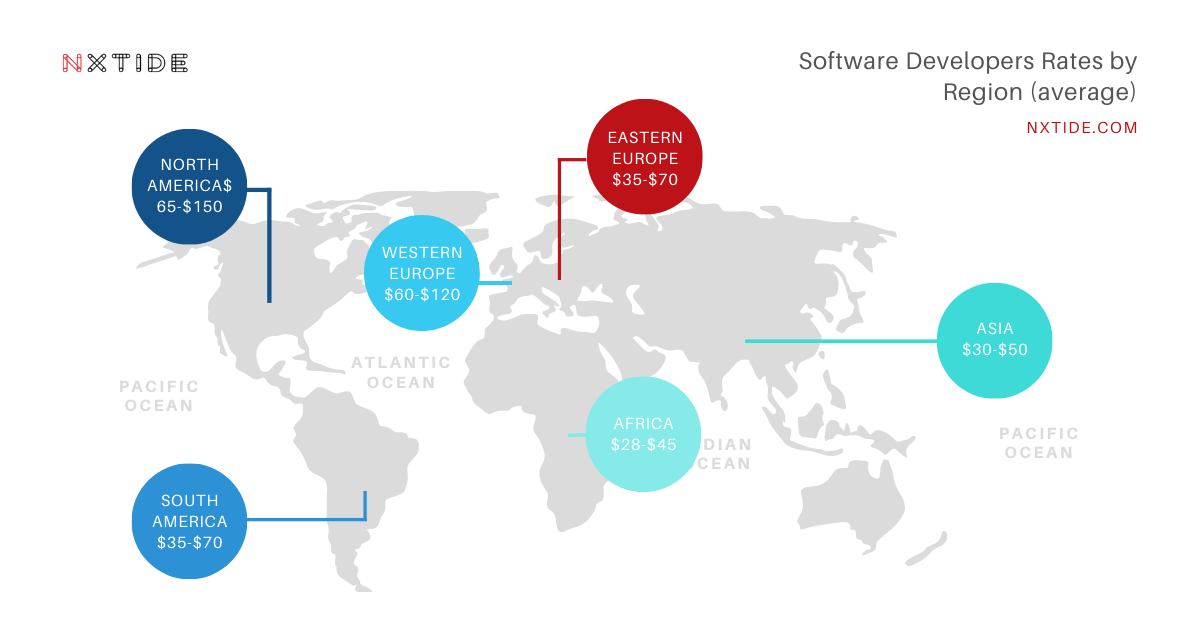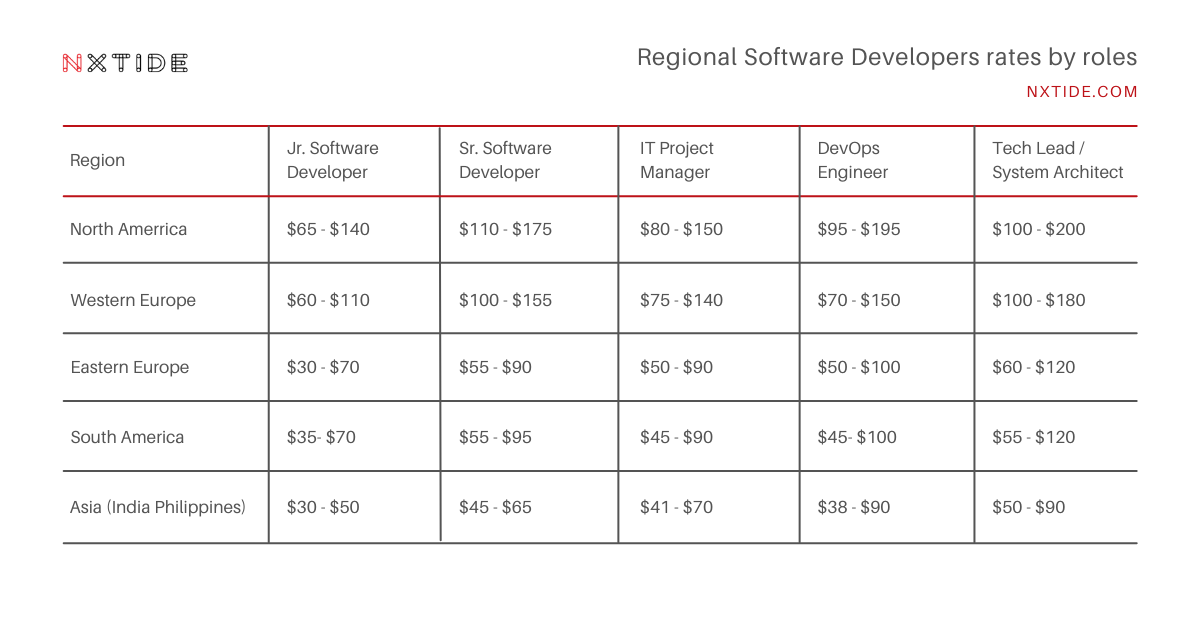Offshore Development Center – Guide to Offshore Software Development

Offshore Development Center - Guide to Offshore Software Development
The world is becoming more digital at a rapid pace. This puts enormous pressure on companies to transform the way they operate based on software solutions – and these transformations require a lot of IT skills to be involved. It’s no wonder, then, that the demand for software engineers is increasing exponentially. The latest figures estimate the global number of unfilled IT vacancies will reach 10 million by 2025 (more to read about software developers shortage).
Hiring a high-quality software developer may be expensive, regardless of whether you work in New York City, Paris, Berlin, or any other brilliant city lights. You’ll have to pay for a wide range of additional costs, including taxes, pensions, and equipment, in addition to your regular salary.
To minimize their financial pressures, forward-thinking firms are exploring the option of establishing ODC (offshore software development centers) or other offshore software development locations to offset the expense of expanding their software business. And compelling reasons like reduced expenses, simpler taxation, and access to a worldwide talent pool tip the scales in favor of doing so.
With that in mind, let’s have a more thorough look at this business strategy, its advantages, and its drawbacks.
What is an Offshore Development Center?
Simply put, an Offshore Development Center is a remote software development team (or simply software development center) located in a different country than your company’s headquarters. Offshore Development Centers can provide a wide range of services, but they’re often used to outsource software development work – that is, to farm out the programming, design, testing, and other tasks required to create software products.
There are a few different models for setting up an Offshore Development Center. The most common model is to have the ODC be a subsidiary of the company. However, it’s also possible to establish a joint venture or to work with an offshore software development services provider. The benefits and drawbacks of each model vary, so it’s important to choose the option that’s best for your company.
What is an offshore software development team?
What is the offshore software development cost?
What are the software development benefits?
- Lower Costs: Offshore software development can result in significant cost savings compared to hiring an in-house team or outsourcing to a local firm.
- Access to a Broader Talent Pool: Offshore software development allows companies to access a larger pool of skilled software developers, enabling them to find the best fit for their project needs.
- Improved Time-to-Market: Offshore development teams can work around the clock, allowing for faster project completion and improved time-to-market.
- Flexibility: Offshore teams can quickly ramp up or down as needed, providing companies with the flexibility to adjust their development resources based on changing business requirements.
- Focus on Core Competencies: By outsourcing non-core functions such as software development, companies can free up resources and focus on their core competencies.
What are the software development risks?
- Communication Barriers: Cultural, language and time-zone differences can create communication challenges that negatively impact project quality and delivery.
- Quality Concerns: There may be quality control issues with offshore software development, as the team may not have the same level of expertise or experience as a local firm.
- Intellectual Property Risks: Sharing sensitive business information with an offshore team can expose companies to intellectual property risks.
- Lack of Control: With an offshore development team, companies may have limited control over project direction, progress, and outcome.
- Dependence on a Single Location: Companies relying on offshore development teams may become overly dependent on a single location or vendor, making them vulnerable to geopolitical, economic, or natural disruptions.
- Managing Remote Teams: Managing remote teams can be challenging, and companies may have difficulty ensuring that their offshore development team is motivated, productive, and aligned with their business goals.
Offshore Software Development Center vs simple outsourcing.
Outsourcing may assist a firm with a serious lack of software engineers or to cut development expenses when required. The worldwide outsourcing industry was valued at more than $98 billion in 2020 and has continued to grow ever since.
Offshore software development is a particular subset of this industry, and it’s growing even faster.

However, Offshore Development Centers should not be confused with traditional IT outsourcing. There are several key distinctions between the two:
– ODCs are owned and operated by the client company, while outsourced work is typically handled by a third-party service provider.
– ODCs are usually used to outsource entire software development projects, while outsourcing is typically used for individual tasks or functions.
– ODCs are located in a different country than the client company’s headquarters, while outsourced work can be done anywhere in the world.
– ODCs provide a number of services in addition to software development, while outsourcing is limited to programming, design, and testing.
Other defined criteria that make Offshore Development Center different from outsourcing.
Project length – Unlike outsourcing which is universal for any project size, offshore development centers cater to complex ventures that require consistent support.
Commitment – The ODC model compares favorably with outsourcing on this one. Since the former presupposes a dedicated team focused on one client, your project will get the undivided attention of hired specialists.
Team size – While outsourcing allows you to recruit just one developer to fill your tech gaps, the ODC approach is supplied inset with a whole team of specialists.
Hiring type – Your tech partner performs a rigorous screening before hiring coders for your ODC. All personnel is hand-picked to meet your unique requirements.
Support – Within the traditional outsourcing model, the administrative department belongs to the vendor’s office. On the contrary, the ODC approach lets you set up a whole team including your own accountant, office manager, and HR.
Scaling perspectives – When establishing an ODC office, you can reckon for limitless scaling opportunities, whereas outsourcing lets you augment your team for a set period of time
Offshore Development Center vs Nearshore Development Office.
Another option to outsource software development is Nearshore Development Offices. A Nearshore Development Office is a remote software development team or unit located in a different country than your company’s headquarters but in the same time zone and/or cultural region.
Offshore Development Centers can provide a wide range of services, but they’re often used to outsource software development work – that is, to farm out the programming, design, testing, and other tasks required to create software products.
There are a few different models for setting up an Offshore Development Center. The most common model is to have the ODC be a subsidiary of the company. However, it’s also possible to establish a joint venture or to work with an offshore software development services provider.

Another option to outsource software development is Nearshore Development Office model.. The NDO is a remote software development team or unit located in a different country than your company’s headquarters but in the same time zone and/or cultural region.
The difference between ODC and NDO is very thin and these terms are often used together. NDOs might be considered as a more “safe” but also more costly option.
The key Offshore Development Center models.
There are several options for setting up an Offshore Development Center, each with its own set of advantages and disadvantages. The most appropriate option will depend on your specific business needs and goals. Here’s a brief overview of the three most common models:
1) Managed ODC model.
The managed ODC model is when the client company hires an offshore software development services provider to manage and operate the Offshore Development Center. Under this arrangement, the provider becomes responsible for all aspects of setting up and running the ODC, including recruiting and managing the team of developers, providing office space and equipment, and handling all HR and administrative tasks. The provider also assumes responsibility for delivering the agreed-upon services to the client company.
This model offers a number of advantages: – The provider has the experience and expertise to set up and operate an ODC quickly and efficiently. – The provider has a large pool of developers to draw from, so it’s likely to have the skills and experience required to match your specific project needs. – The provider is responsible for all HR and administrative tasks, so you don’t have to worry about hiring and managing a team of developers in-house. – The provider is responsible for delivering the services agreed upon, so you can be assured that the work will be done to your specifications.
The main disadvantage of this model is that it can be expensive, as the provider will typically charge a management fee in addition to the cost of the developers’ salaries.
2) Build Operate Transfer ODC model.
Under the BOT (build, operate, and transfer) Offshore Development Center model, the client company contracts with an offshore software development services provider to build and operate an Offshore Development Center for a fixed period of time. At the end of the contract, the ODC is transferred to the client company.
This model offers a number of advantages:
– The provider is responsible for setting up and running the ODC, so you don’t have to worry about any of the logistics.
– The provider has the experience and expertise to quickly set up an ODC and get it up and running.
– The provider has a large pool of developers to draw from, so it’s likely to have the skills and experience required to match your specific project needs.
– The agreement is for a fixed period of time, so you can be assured that the ODC will be transferred to you at the end of the contract.
The main disadvantage of this model is that it can be expensive, as the provider will typically charge a set-up fee and a management fee.
3) Joint Venture ODC model.
Another option for setting up an Offshore Development Center is to establish a joint venture with an offshore software development services provider. Under this arrangement, the two companies form a partnership to create and operate the ODC.
This model offers a number of advantages:
– The partner companies share the cost of setting up and running the ODC, so it’s more affordable than the other models.
– The partner companies share the risk, so both parties are invested in the success of the ODC.
– The partner companies have complementary skills and expertise, so they can work together to create a successful ODC.
The main disadvantage of this model is that it can be more complex to set up and manage than the other models.
More about BOT model can be found here.

When to consider an Offshore Development Center model?
If you are hunting for a faster, cheaper, more effective alternative to put your business output in full gear, offshore development center outsourcing is probably your first election.
However, not all projects and business processes are meant for this scaling opportunity. This is why we’ve provided you with a cheat sheet that will tell you whether or not ODC is the right call for your needs.
1) You are aiming for large-scale projects
In the case of offshore development centers, you shouldn’t waste talents on trifles. Unlike the traditional outsourcing option where a single function can be delegated to a remote developer, the ODC team is typically composed of diverse specialists. Thus, you can only hire a development team including programmers, QA specialists, back-end and front-end developers, web and UI/UX designers, and a whole host of other talents.
2) You want to enter a particular market
Setting up an ODC team also opens up new market opportunities in the chosen development destination. There is nothing more challenging and unpredictable than breaking into an unknown market, especially if you’re not familiar with the local business processes. A support network in the form of high-quality professionals will surely give you a head start and alleviate a lot of headaches.
3) You are in need of a large and diverse team
Instead of gathering a killer development team by crumbs, an ODC offshore development center comes complete with a talent-loaded team that is fine-tuned to your unique business needs. This differentiates the hiring model in question from other recruitment options like freelancing and traditional outsourcing.
4) You want to increase the development security
Since offshore development centers presuppose a geographically distributed process, the parties involved put in place comprehensive technical security measures during the development of the software. Along with traditional safeguards such as a Non-disclosure agreement, an outsourcing vendor also ensures the physical security of data and the security of your final product.
5) You want to scale on a budget
Unlike building up your in-house workforce, ODC models of remote staffing do not include any financial resources for workspace, equipment, and tech talent hiring. All you have to do is to delegate the task to your service provider and onboard a dedicated team for your project.
6) Your project requires particular tech expertise
As compared to the market needs, the tech talent landscape runs short for software development specialists even in gigantic companies like General Electric.
Hence, finding the rare tech stacks appears impossible in some countries. The offshore development center model is your big-ticket with diverse teams brimming with coveted skills.

Challenges with building an Offshore Development Center
Despite an impressive number of benefits that accompany this hiring model, there do exist a few pitfalls. Thus, here are some of the top challenges that deter some companies from this outsourcing model:
1) Cultural barriers impact the overall performance This point is among the most oft-cited offshore development center challenges. Every company follows different cultural practices, including accountability, workload sharing, way of interaction, time management, and formalities. This makes it challenging to onboard a whole team of experts with a different cultural mindset and established workflow.
2) Nightmarish Logistics Keeping both an outsourced office and in-house team on the same page may seem like an unnerving experience. Add to that deadlines, meetings, phone calls, and drastically different time zones, and you’re looking at dragged-out turnaround times. However, finding a vendor in a convenient time zone and stable communication can make a huge difference.
3) Unrealistic Expectations A company may set the bar too high for a service provider or expect an ODC to take care of all business processes. Such air castles can lead to project failure and general frustration for both sides, not to mention poor team performance. To address this challenge, parties should discuss all roles and end goals beforehand to avoid further misunderstanding.
Common Steps in building an Offshore Development Center
Now that we’ve studied the science behind ODC, let’s move on to the actual work required to actually launch it. To help you create a win-win offshore strategy, we’ll guide you through this challenging process step by step.
1) Choose location
Unfold your offshore experience by pointing to the right geographical location. The absolute winners in the outsourcing race are Eastern Europe and Asia which outperform other locations due to large IT talent pools and attractiveness of rates. Besides the winning price-value ratio, companies should base their choice on the required technical skills and cultural specifics.
2) Choose a vendor
Choosing a vendor is a delicate process that requires some deep research. Along with standard screening procedures like studying a vendor’s portfolio and previous projects, there is a whole host of other indicators that demonstrate the reliability of the chosen partner. We’ll discuss this point further in the article.
3) Select ODC Model
As with most models, there isn’t just one Offshore Development Center model that works wonders for all companies. Prior to making this choice, make sure you’re well aware of your current state of affairs and have a clear business objective. Based on these insights, choose between BOT and managed ODC models.
4) Define the dedicated development team requirements.
When you’ve finally taken up all organizational matters, break the ice of the recruitment process. At this stage, you should provide detailed professional requirements to your vendor so that he can analyze the current employment market and select the first suitable candidates.
5) Interview candidates (or allow the vendor to do that)
Once the vendor presents the best matches for your review, there begins the next phase of the recruiting process. To pick the cream of the crop, you should interview final candidates by setting Skype calls or arranging personal meetings. You can also delegate this procedure to your vendor.
6) Rent an office & equip it (if needed)
While recruiters are handpicking tech talents for your offshore development center, start the searches for a physical office where the future team will work. Consider contacting real estate managers to choose a perfect location with parking lots, a security system, and other amenities. Or delegate it to your vendor if you’re considering a separate office.
7) Contract a team
Finish the hiring process by sending job offers. As soon as the first developers get down to work, the offshore development center is finally up and running.
8) Onboard new staff
Don’t forget to onboard new hires which is sometimes followed by on-site meetings in the main office. Start your project Once you assign roles and responsibilities, your newly-minted workforce will buckle down to their work.
How to choose and verify an Offshore Development Company?
There are a lot of companies offering offshore development center services. Like any other selection process, there are various factors that determine the choice of the right ODC company.
To save you time and effort, we’ve compiled the key factors to keep in view.

1) Portfolio The impressive list of projects and services rendered is the first thing to take note of when choosing your ODC partner. Having an expert vendor on your side gives you an added bonus as you do not have to worry about the complex details related to the services.
2) Testimonials Taking into account the reputation of the vendor will provide even more insights into his services than a standout portfolio. When studying the past projects, you will get a better idea of whether or not their services are up to your standards, and that it is maintained unceasingly.
3) English proficiency A solid grasp of the English language ensures that your outsourced personnel can understand business presentations and communicate descriptions of problems and solutions. It also indicates that developers can take an active role in everyday business discussions and the execution of complex tasks.
4) Responsiveness
There is nothing more important for a successful tech project than thorough and frequent communication. Although it’s impossible to find out the degree of collaboration before the working process begins, you can get an idea of the vendor’s communication culture at the early stages. If the chosen company takes the time to address your inquiries quickly and substantially, that’s always a good sign.
5) Legal matters Finally, a reliable ODC vendor should be aware of and comply with your patents and intellectual property rights. Before deciding on the partner, make sure the company provides the confidentiality agreements and is ready to conform to your standards and regulations.
Top countries to set up an Offshore Software Development Center
There are plenty of offshoring IT destinations around the globe. The leading locations are rapidly evolving in terms of technical skills, competence, and tech expertise as well as boast a reasonable quality-to-cost ratio and vast tech talent pool. Thanks to rampant globalization, you are not limited to a small number of ODC locations. The success or failure of this business model will hinge on the country as well, and in today’s “flat world” scenario, the options are frighteningly broad.
Nowadays the focus of outsourcing is placed on Central & Eastern Europe Ukraine in particular, due to the proximity of time zones, good cultural fit, and mature tech infrastructure. At the same time, Asian countries, such as India, have made an entrance with new talents and attractive pricing. Let’s have a look at some of the other most popular destinations country comes out as an outsourcing winner.

Poland
Poland is an up-and-coming destination for software outsourcing. It offers a large talent pool, good infrastructure, and reasonable pricing. The cultural fit is also excellent, as the country shares many similarities with Western Europe.
Romania
Similar to Poland, Romania offers a large talent pool, good infrastructure, and reasonable pricing. The cultural fit is also very good, as Romanians share similar values with other Europeans. The main drawback is the lack of language proficiency in English.
Ukraine
Located in Eastern Europe, Ukraine has a well-educated and highly skilled workforce. The quality of work is excellent, thanks to the strong engineering and technical education system. The cost of living and doing business is also very reasonable, making Ukraine an attractive destination for outsourcing. The main drawbacks are the distance from other European markets and the lack of language proficiency in English.
India
Offering a vast talent pool, India is a popular destination for software outsourcing. The country has a strong engineering and technical education system, which produces highly skilled workers. The cost of living and doing business is also very reasonable, making India an attractive destination for outsourcing. However, the cultural fit and quality of education can be difficult to tackle together with distance.
China
If you spin the globe looking for other locations, China also holds a big chunk of the global technology sourcing market. This country has a strong export platform on which to build an outsourcing industry.
The Big Tech companies investing in Offshore Development Centers in Poland.

It is no secret that the technology sector is booming. New technologies like cloud computing, the internet of things, machine learning and artificial intelligence are changing the way we live and work. In order to stay ahead of the curve, the big tech companies must hire more software developers and IT specialists to grow and maintain their IT services.
The software developers’ shortage.
The major problem they encounter on their way is the IT talent gap. There are simply not enough skilled IT professionals to go around, and this is especially true in developed countries. The numbers are staggering. In the United States, for example, there are currently around 320,000 unfilled jobs in the IT sector. In the EU, that number is around 1.1 million.
The consequences of the IT skills gap are far-reaching. It is estimated that, by 2020, the global economy will lose $5 trillion because of the shortage of qualified IT professionals. This software engineers shortage is driving companies to look for talent in other places. Offshore Development Centers (ODCs) are becoming increasingly popular, as they allow companies to get access to skilled professionals at a fraction of the cost. And one of the best places to set up an ODC is actually Poland, the center of the CEE region.

Why Big Tech has opened offshore development centers in Poland
Poland has become a popular destination for offshore development center services, partly because it’s been a member of the European Union since 2004. The country offers a number of benefits, including a well-educated workforce, strong infrastructure, and proximity to major markets in Europe. In addition, the cost of doing business in Poland is relatively low when compared to other Western European countries.
Several big tech companies have already set up shop in Poland. These include Apple, Facebook, Google, and IBM. Offshore development centers in Poland offer these companies a number of advantages. Let’s take a look at some case studies:
Google opens Software Hub in Poland
In an effort to tap into the large pool of talented Polish developers, Google has announced the opening of a new software hub in the city of Krakow. The hub will serve as a regional center for Google’s operations in Central and Eastern Europe. It will be home to a number of engineering teams that will work on developing new software products and services.
The new software hub is part of Google’s efforts to expand its presence in Poland. In addition to the software hub, Google also operates a number of other facilities in Poland, including a sales office, data center, and an artificial intelligence research lab.
Apple expands Offshore Development Center in Poland
Apple has been able to reduce its costs by outsourcing labor-intensive tasks to Poland. In addition, the center has helped the company maintain a fast pace of innovation. The company has announced plans to expand its Offshore Development Center (ODC) in the city of Krakow. The expansion will add 300 new jobs to the center.
The Offshore Development Center in Krakow was established in 2015. It is home to a team of engineers who work on developing software for Apple’s products. The center has been successful in helping Apple reduce its costs and speed up the pace of innovation.
Facebook expands Offshore Development Center in Poland
In an effort to better serve the European market, Facebook has announced plans to expand its Offshore Development Center (ODC) in the city of Warsaw. The expansion will add 100 new jobs to the center.
The Offshore Development Center in Warsaw was established in 2013. It is home to a team of engineers who work on developing software for Facebook’s products. The center has been successful in helping Facebook localize its products for the European market. It allowed the company to quickly and easily localize its products for the European market.
IBM expands Offshore Development Center in Poland
IBM has announced plans to expand its Offshore Development Center (ODC) in the city of Wroclaw. The expansion will add 200 new jobs to the center. The Offshore Development Center in Wroclaw was established in 2013. It is home to a team of engineers who work on developing software for IBM’s products. The center has been successful in helping IBM develop innovative new software products and services.
Cisco opened its Krakow campus in 2012.
The company is well-known for its network infrastructure solutions and now employs 2 000 people in Krakow, including 1000 engineers/IT specialists. The campus in Krakow offers a wide range of services, from R&D and software engineering to contact center operations.
Intel has been present in Poland since 1996.
According to the official data, the company employs over 4 000 people in the country. Intel’s Polish operations comprise of a design center in Gdansk, a software engineering center in Krakow, and a research and development center in Warsaw.
Private Equity and Venture Capital funds investments in Poland
According to Polish Investment and Trade Agency, the PE / VC funds have invested over EUR 12 billion in Poland so far. Poland already ranks first in terms of the number and total capitalization of the digital and technology companies in the CEE region, according to the Digital Champions CEE report.
A country is deemed as an ideal place for the development of all kinds of startups, whose innovation and maturity of concepts are valued all over the world (eg. Livechat, Zowie, KP Labs, Symmetrical, Linker, Autonomous Systems, Brand24, eDrone, Booksy, Brainly, Surfer). This opinion has been also confirmed by the results of the CEO World Magazine survey, in which Poland was chosen as the seventh, most startup-friendly country.
In the years 2014-2020, thanks to the SmartGrowth operational program, co-financed by the EU, 420 research and development centers were established in Poland, which seems to be a very solid foundation for the upcoming R&D boom.
The offshore software development center service providers.
There are a number of companies in Poland that offer dedicated offshore development center services, and we’re one of the most experienced among them. We have a wealth of experience and expertise in setting up and managing offshore development centers. We can help companies from all industries get the most out of their offshore development center.

The benefits of cooperating with offshore software development center providers:
– Faster delivery time to market (it is faster to do it with the company already in place)
– Limited risks (ODC providers have more experience and know-how of the local market and they share the risks with the clients)
– Cost savings (especially in the initial stage of the project)
– Larger scaling potential (ODC vendors usually have the potential to scale development teams much more efficient)
– Quality control (the use of ODC providers usually results in better quality software products)
Building an Offshore Development Center in Poland

An Offshore Development Center, also known as an ODC, is a dedicated development office with a software development team in a foreign offshore or nearshore country. In other words, this is a firm’s subsidiary in another location with a large pool of talents and relatively lower costs. The ODC has proved to be a very effective business model for dedicated IT projects for companies from any industry around the world. Let’s now analyze this interesting topic in the next paragraphs.
The history of offshore development centers
In recent years, software engineers and programmers have been in greater demand all around the world. Rapid technological growth, digital transformation of modern companies requires more technical competencies than ever. According to the US Bureau of Labor Statistics, employment in the software development industry is expected to increase by 22% between 2020 and 2030. Each year on average, there will be about 189,200 openings for software engineers (in US only).
The supply of technology IT talent has not kept pace with the growth in investment in technology throughout all organizations in recent years. The Covid-19 pandemic may have put investments on ice initially, but now that the epidemic is over, a significant number of businesses are looking to further reallocate technology spending. The tech industry has also experienced a solid boost in venture capital, which has led to an influx of new companies looking for engineers. At the same time, the established tech companies are still hiring at a high rate. As a result, the demand for software engineers is projected to be greater than ever.
All these coinciding factors are the major reasons why companies are struggling to find adequately skilled computer science and engineering professionals. This dangerous trend isn’t only happening in the United States, of course, as similar demand has been seen in Europe, Australia, and many other parts of the world.
The failure of traditional software developers outsourcing (and the rise of offshore software development).
Traditional outsourcing was the first wave of solutions to handle (or to tame) the problem for many years. Companies have tried to outsource projects, hire temporary experts locally, or based on travel contracts. The solution has worked for small or temporary projects but has failed when it comes to building stable, long-lasting, quality centers of competence inside the companies. There was a need to find a solution comparable to the local, internal teams when employees can feel the real bond with the brand and its values.

The success of offshore development centers.
Offshore development centers (ODC) became a backbone of software development expertise behind many successful North American and West European companies. This approach to handling a project lets organizations’ leaders scale their local teams with skilled engineers, trim expenses, and for the most secure the future company growth. The ODC have presented much more stability and strategical planning to the industry by:
1) focusing on creating the real, operational software development teams (remote teams) not only providing HR headhunting services
2) focusing on client goals and success with respect to the company brand identity and values
3) improving security, standardization, and core IP protection
4) providing resources and local know-how to software development projects in a faster and more efficient way

Who Needs an Offshore Software Development Center (ODC)?
The first companies that applied this new concept were of course those from the big tech and tech startup industry. However, in recent years this trend started spreading to other non-tech industries. They are no limitations here. Every company can own a software development center or at least set up a offshore development team to secure future growth at a reasonable price.

Ready to start your own offshore development center?
Creating a offshore software development center is not an easy task locally. It requires great planning, strategy, time, resources, and a little bit of luck. You will have to deal with remote team management all the time.
At NxTide we have created a very transparent, win win offshore strategy to deal with demanding projects for customers from North America, Europe, and the Middle East regions.
Steps to take to set up an offshore software development center
Now, when we know the basic characteristic of an ODC we can go deeper into the necessary steps to take to mitigate major risks of a future software development project:
1) Prepare an offshore strategy
This is something every successful Project Manager does. Without this step, you’ll waste a lot of time. The document should contain: goals, time frame, budget, other, resources, expected effects, return on investment. Based on that you’ll be able to filter appropriate offers.
2) Choose a location for a potential offshore software development center
The first step here is to analyze the average software developer hourly rates from the outsourcing market. Choose max 10 locations and compare everything in an excel file. If several of them meet your budget criteria you can go and analyze locations based on several factors: location proximity (the closer the better) software developers poll size country educational system country business infrastructure and safety the development of a local outsourcing market cultural matters In this article, we talk a little bit more about this matter. There are some great locations in trend right now like Mexico, Brazil, and CEE Region. We would kindly recommend taking a closer look at Poland, one of the largest IT talent pools worldwide.
3) Find a reputable local IT Partner (ODC, BOT)
There are cases of large companies that decided to establish the local entity and the whole business process by themselves. The only help they needed was during the recruitment process. However this strategy requires resources and time, and as we know in IT time is the most valuable resource. This is why we recommend finding an experienced and dedicated IT Partner that will help you handle operations, mitigate risks, and generally start the project faster. At NxTide for example we start building a dedicated team (including the Project Manager) for the project the same day we sign the agreement.
Screen the best vendors:
– look at their experience and specialization (HR agency is not a technological partner)
– analyze Management background (look for IT skills, experience)
– analyze current customers and request some testimonials from them analyze the company financial records (make sure that your partner will handle the effort of the large project)
– conduct interviews and discuss KPI’s with the Management of every IT partner (make sure that they will follow the plan)
How can we help in launching offshore software development center?
NxTide is a specialized company focusing on building local, remote Software Development Teams or larger Software Development Centers in major cities in Poland. We take care of all recruitment and quality control processes making it faster and more cost-effective for you. Here is some more information about our expertise: – Over 7 years experience in creating a variety of software development teams – Over 60 teams and 300 engineers successfully hired and deployed – Several dedicated HR and IT Project Management Teams acting on your behalf
Please take a closer look at a dedicated and flexible offer we have prepared based on market needs:
1) Software Development Teams: dedicated to clients looking to expand their software development teams or create small remote teams from scratch.
2) Nearshore / Offshore Development Center: dedicated to larger and permanent projects. We’ve implemented the innovative Build Operate Transfer model to make the whole process faster, more efficient, and transparent. Please read more about us here: https://nxtide.com/about-us/
Other related articles that might interests you:

Offshore Development Center – Guide to Offshore Software Development
The world is becoming more digital at a rapid pace. It’s no wonder, then, that the demand for software engineers…

KodyPay: Scaling a software development team for one of the best mobile payment applications.
Home KodyPay: Scaling a software development team for one of the best mobile payment startups. Client details KodyPay Ltd, UK…

Where to Locate a Software Development Hub, R&D, or IT Center for Your Business?
Home Where to Locate a Software Development Hub, R&D, or IT Center for Your Business? We all are aware that…








